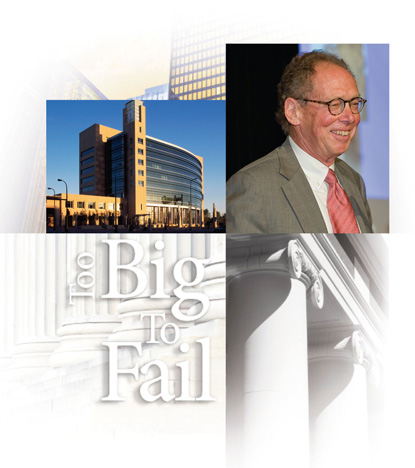
In an essay written years ago about a Minneapolis Fed colleague, Gary Stern observed that employee “contributions are not always fully recognized and appreciated at the time, and yet over time, they define the Bank.”
To an extent we’ve only begun to fathom, Stern has defined the Minneapolis Fed. He shaped us while he was here, and his influence will be felt for years to come, both at Minneapolis and in the world at large. I’ve had the privilege of working alongside him for over two and a half decades, and while others may offer different thoughts, I hazard to suggest that his most long-lasting contributions will be found in his deep support for economic research and his extensive influence on Fed policy.
Under Stern’s leadership, the Minneapolis Research department has become one of the best in the world, recognized for pioneering work on rational expectations, moral hazard, models of money, real business cycle theory, time consistent policies and most recently, lessons learned from the Great Depressions of the 20th century.
By no means did Stern agree with every theory or line of research that came out of our department, but he steadfastly supported the spirit of independent inquiry that is at its core. And without question, Minneapolis research frequently influenced the bank’s policy positions—sometimes by convincing Stern of the power of a concept and often by failing to show that he was wrong.
As a Fed president for nearly a quarter of a century, Stern made significant contributions in many areas of economic policy, but there are four in particular where he had profound influence—where he saw things most neglected, and advocated measures before others knew they were essential. In fact, his column Priorities for the Federal Reserve in this issue of The Region emphasizes several of these.
- Too big to fail
The man and the phrase have been all but inseparable over the past decade. Stern has given countless speeches, written numerous articles, delivered Senate testimony and, of course, co-authored a book on a topic that once seemed obscure and now is inescapable in debate over financial reform. - Financial services
As chair of the Fed’s Financial Services Policy Committee for six years, Stern played a central role in reshaping the Federal Reserve as the financial world evolved from paper checks to electronic payments. Maintaining high levels of efficiency and quality were essential during this deep structural and functional transformation of the Fed’s payments system, and Stern’s leadership ensured that those goals were met and exceeded. - Economic literacy
It goes without saying that Stern is passionate about good economics, and he brought that enthusiasm with full measure to the task of improving public economic literacy. As chair of the Council on Economic Education, he spoke tirelessly on the subject, noting that “economic literacy is crucial because it [helps] people understand the forces that significantly affect the quality of their lives.” That truth is even more relevant today, in the midst of financial crisis, than when he said it over a decade ago. - Price stability
“In the long run, the most significant contribution monetary policy can make to achieving maximum sustainable growth in real output is to foster price stability,” Stern told the Senate Committee on Banking, Housing and Urban Affairs in 1993. As a long-serving member of the Federal Open Market Committee, Stern vigorously and persistently argued that price stability must remain the overarching goal of monetary policy—a position once controversial but now unquestioned.
Much remains to be done in each of these policy arenas, and economic research will continue to advance despite his departure from the Minneapolis Fed. But had it not been for Stern's foresight, eloquence and perseverance, we would never have begun to address them and could not have hope of a time when they will no longer be issues of the day.
—Art Rolnick
Senior Vice President
Director of Research
Too Big to Fail
Reform of the financial services industry is currently at the forefront of America’s domestic agenda.
The proposed reforms of the deposit insurance system do not address the fundamental flaw in the system, namely the moral hazard problem. As matters now stand, risk taking in banking is underpriced and, as a consequence of this mispricing, depository institutions whose liabilities are insured take on more risk than they should. …
We must start by correcting the incentives and redressing the misallocation of resources resulting from the current deposit insurance system and the “too big to fail” doctrine.
The Proposals for Reform that are “On the Table”
Top of the Ninth
The Region
June 1991
In 1991 Congress passed the Federal Deposit Insurance Corp. Improvement Act (FDICIA).
FDICIA did not go far enough in addressing the moral hazard problem. The recent success of the banking industry should not lull us into a false sense of security. Another banking crisis is possible and this time—with ever larger and more complex banks—the costs could be even greater. The time is right for uninsured depositors to become truly uninsured, and thus reduce the insidious effect of moral hazard in the banking industry.
The Too Big to Fail Problem: A proposal to reform deposit insurance
The Region
September 1997
Three Bottom Lines
First, the TBTF problem has not been solved, is getting worse, and leads, on balance, to wasted resources.
Second, although expectations of bailouts by uninsured creditors at large banks cannot be eliminated, they can be reduced and better managed through a credible commitment to impose losses. Policymakers can establish credible commitments by addressing and reducing the motivation for bailouts.
Third, although other reforms could help to establish a credible commitment, policymakers should give highest priority to reforms limiting the chance that one bank’s failure will threaten the solvency of other banks.
Too Big to Fail: The Hazards of Bank Bailouts
(Brookings Institution Press, 2004)
Gary H. Stern and Ron J. Feldman
The Treasury has recently come forward with an ambitious [reform] proposal. …
The issue in question is too-big-to-fail (TBTF), now widely if belatedly acknowledged as an exceedingly costly problem. … I have in fact spoken and written extensively—some might say obsessively—about TBTF over the past five years. …. How is it that we put high priority on the growing TBTF problem and its ramifications when others did not? The short and direct answer to this question is that we focused on understanding the incentives. …
This emphasis on incentives is not accidental. To the contrary, I am convinced that just as incentives were at the heart of the TBTF problem, they necessarily must be at the heart of the solution. … The Treasury proposal … largely fails in this regard. … In fact, there is nothing in the Treasury proposal designed to put creditors of large, systemically important financial institutions at risk of loss.
Remarks to Helena Business Leaders
Helena, Montana
July 9, 2009
Financial Services
The payments system in the United States operates so effectively and efficiently that in fact most people never give it a thought—they simply take it for granted. But it requires considerable resources and coordination, from both the banking system and the Federal Reserve, to make the payments system function as it does.
Direct involvement in payments has proven valuable to the Federal Reserve in fostering a comprehensive understanding of both how particular markets work and how to restore stability when disruptions occur.
Carter Glass was right: The structure of the Federal Reserve is important
Top of the Ninth
The Region
December 1997
The role of the Federal Reserve System as a payment services provider is likely less well-known among the general public, and yet this function demands a great deal of our time and effort. The collection of checks, the processing of electronic funds transfers and the provision of net settlement services to private clearing arrangements may seem rather arcane, but they are also rather important for a smooth-running economy.
The question at hand regards the Federal Reserve’s role in the payments system, generally speaking, but specifically its role in a system that is undergoing rapid change due to technological and institutional innovations.
Message from the President
2000 Annual Report
April 2001
The Federal Reserve has to strike an appropriate balance between remaining an effective participant in retail payments while assuring that the private sector has ample opportunity to innovate and to prosper as markets evolve.
Remarks at the Emerging Payments Conference
Federal Reserve Bank of Chicago
May 30, 2003
When I took on oversight responsibility for the Fed’s payments business, I tried to articulate something … which continues the tradition of looking to economics rather than to profit/loss to guide our direct provision of payments. We settled on the following: The Federal Reserve should ensure that the size, reliability and capabilities of its basic retail infrastructure supporting established services correspond to market demand. Most importantly, where demand for our services is diminishing, we should reduce our provision. This hardly sounds revolutionary, I know, but government has not always been willing to shrink or terminate long-standing programs. On the other hand, where demand is increasing and others cannot or will not meet it, we should expand our activity.
Economic Research and the Role of the Federal Reserve in Payments
Top of the Ninth
The Region
December 2005
Economic Literacy
We will not have responsible government policies until the public demands it. The public, meanwhile, can’t demand it unless the public is adequately educated and informed.
The public needs enough economic knowledge to understand the trade-offs it faces. … A most fundamental lesson from economics is that resources are limited and we have to choose how to allocate those resources given the feasible trade-offs.
An Educational Deficit
Top of the Ninth
The Region
December 1992
Economic literacy is crucial because it is a measure of whether people understand the forces that significantly affect the quality of their lives.
You cannot fully understand history without understanding economics. You cannot understand politics and other social sciences—in other words, how the world works—without understanding economics. And you cannot make an informed choice when you walk into the voting booth.
Do We Know Enough About Economics?
Top of the Ninth
The Region
December 1998
Why is economic education important? [This question] might be particularly relevant for the United States, where economic literacy is "low" and yet the economy has done well and living standards are high.
I am convinced that the short answer … is that the invisible hand works better when participants in the economy and its myriad of markets—when consumers, business people, elected officials, investors, policymakers and so on—are well educated in economics, when they are economically and financially literate. Going one step further, the economy performs better when its participants are well informed because well-informed participants make decisions that enhance resource allocation, and thus contribute to rising efficiency, productivity and living standards.
From Pocketbook to Policymaking, Economic Education Matters
Top of the Ninth
The Region
June 2002
Enduring economic progress and prosperity depend on public institutions’ ability to commit to policies that are optimal over the long haul, across the temporary ups and downs of the business cycle. In a democracy, such policy commitments can only be sustained with broad public support, and public support for good policies depends, in turn, on voters’ competence in basic economic reasoning.
The public was educated about inflation at a high price, amid the economic dislocations of the 1970s and early 1980s. I prefer that economic education be pursued more benignly, in the classroom and the press, and more proactively, before rather than after it is needed.
I view consumer regulation and consumer education as substitutes. If consumers are more educated and able to make good decisions on their own, regulations can be narrower and more focused on clearly abusive practices, such as deceit and fraud.
On Public Policy and Economic Education
Top of the Ninth
The Region
September 2007
Price Stability
The federal budget deficit poses a distinct threat to progress toward reasonable price stability. An overly stimulative fiscal policy sooner or later runs the risk of triggering a reacceleration of price increases. …This danger is particularly grave if … monetary policy is maneuvered into a more accommodative posture than it would otherwise adopt.
Any effort, then, to construct and implement policies that will contribute to sustainable growth with low inflation must include meaningful reductions in prospective federal deficits.
The Transition to Low Inflation: Progress and Pressures
1984 Annual Report
Over the past year or two, there has been considerable discussion of price stability as the preeminent goal of Federal Reserve monetary policy. This discussion has generated support for the goal but has also touched off a variety of concerns, including the compatibility of this objective with other policy goals, the potentially high cost of achieving price stability, and the means of conducting policy to achieve this objective. These concerns are worthy of serious consideration but, on balance, price stability should remain the overarching goal of monetary policy.
In the long run no fundamental incompatibility exists among these multiple objectives. The principal contribution monetary policy can make to achieve sustainable growth and high employment is to establish an environment of overall price-level stability.
The Goal of Price Stability
Top of the Ninth
The Region
February 1990
Low unemployment accompanied by low inflation is not what many commentators and economists had expected. … Instead, they had expected declines in unemployment—and concomitant tightening of labor market conditions—to lead to pressures on wage costs and inflation.
There are, perhaps, at least two lessons in all of this. First, an effort to understand short-run inflation pressures is likely to require a broad-based review of economic conditions going well beyond labor market data. And secondly, it is well to recall that there is an impressive body of research indicating that in the long run inflation is a monetary phenomenon, and thus it is the responsibility of Federal Reserve policy to maintain a low-inflation economy.
Rethinking NAIRU
Top of the Ninth
The Region
June 2000
In thinking about how to sustain the economic performance that we’ve enjoyed in recent decades, and mindful of the role that price stability has played in that success, I am becoming increasingly convinced that monetary policymakers may want to more formally institutionalize the low inflation policy that we’ve followed implicitly over recent decades. Further, I am becoming persuaded that establishing a regime of inflation targeting may be an effective means to do so.
Formalizing the Success of Past Policy
Top of the Ninth
The Region
June 2005




